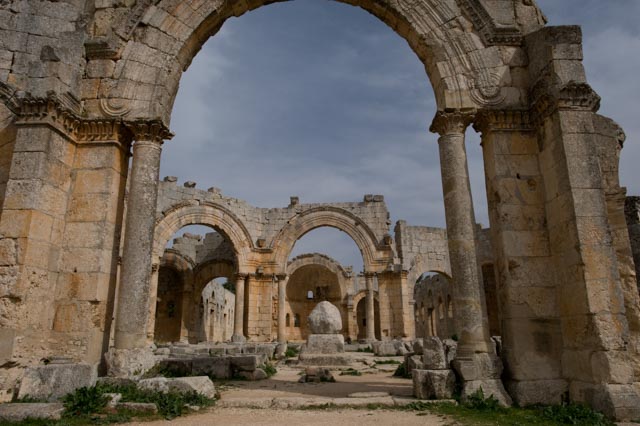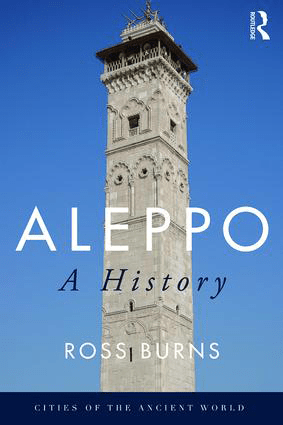The attention given recently to Palmyra, and the first reports of its condition after its recovery from the hands of the so-called Islamic State, have perhaps deflected attention from what is happening to the rest of Syria’s remarkable Classical, Byzantine, Islamic medieval and Ottoman remains.
Aleppo, in particular, has long been neglected (or perhaps written off) by the media since the appalling loss of the wonderful Seljuk-era (11th-century) minaret of the Great Mosque in early 2013. The subsequent destruction (often as deliberate targets rather than incidental casualties of war) of numerous Mamluk and Ottoman buildings has barely been recorded, let alone assessed.
Perhaps then, it should be no surprise to learn that serious damage to the Church of Saint Simeon has not received the attention it deserves. Located 35km east of Aleppo on a position overlooking the once-peaceful valley of the Afrin River, it is the greatest treasure of the Christian-Byzantine era in Syria. The American historian, Howard Crosby Butler, followed a long line of European visitors attracted by the sheer scale and beauty of the complex, which was erected to commemorate the 5th-century saint who had spent the greater part of his life atop a column on this spot. Butler believed that the complex filled an important gap in our understanding of church architecture:
The great cruciform church is unique in the history of architecture and is not only the most beautiful and important existing monument of architecture between the buildings of the Roman period of the second century and the great church of Santa Sophia of Justinian’s time, but also…is the most monumental Christian building earlier than the masterpieces of the eleventh and twelfth centuries in Northern Europe. (Butler, Early Churches in Syria, 1929: p 97)

The courtyard of the Church of St Simeon looking east through the courtyard towards the east basilica. The remaining stub of the saint’s column in the middle of the courtyard has been dislodged by the blast
The complex comprises not one but four great basilica-type halls, with their walls largely intact, facing into a central octagonal courtyard where the saint’s column was preserved. It was built in the 30 years after Simeon’s death (459), and the huge scale of the project was a reflection of the importance the Byzantine Emperor Zeno (474–91) gave to the commemoration of the saint’s life and to the use of his memory to draw the last remaining non-believers around northern Syrian into the faith. Butler – like many earlier writers – admired the details of its beautiful decorative stonework, which anticipated much of the richness of Romanesque and Gothic architecture five centuries later.
The Church of St Simeon was taken by Islamist forces in 2013 to serve as a logistics and training base. It made an arresting backdrop for the well-developed media skills of the Islamist forces, who posed groups of black-veiled women engaged in weapons drills in front of the great southern entrance, with its commanding central arch and its richly decorated capitals swathed with wind-swept acanthus leaves.
The Islamist forces were perhaps confident that the church complex (which included a four-sided monastic establishment wedged between the eastern and southern basilicas) would be off-limits to Syrian official reprisals. It is one of the major Syrian archaeological sites, and was included on the UNESCO World Heritage list as the highlight of the Ancient Villages of Northern Syria group of ruins. Reports have been coming in for over two years of minor damage from firearm impacts on the structure, stone removal, and illegal digging – all sadly common occurrences in the numerous ancient villages in the area.
Opposition elements signalled a new and more deliberate assault on the church and its attached monastery on 12 May. The remains of St Simeon’s column in the central courtyard took the full force of an explosive impact near its supporting base. The blast was so great that the column remains were hurled into the courtyard. One of the columns flanking the south entrance portal was shattered and much of the arch above displaced. More extensive damage, however, has occurred in the monastic grouping: on video clips posted on the internet, two wings appear to have completely collapsed, apparently as a result of separate explosions.
Many opposition groups have struggled for supremacy in this area, clashing with each other as often as against the government forces attempting to win back the vital link into Turkey via the Bab al-Hawa crossing on the Aleppo-Antioch highway. Let us hope that this great complex does not become a new front in the Syrian conflict.
Ross Burns, author of several books on the history and archaeology of Syria, maintains a website at www.monumentsofsyria.com which, inter alia, maintains a checklist of sites damaged in the post-2011 conflict. His history of Aleppo (see cover below), the first in English, is due to be published in September by Routledge.


While the world watches Palmyra, another of Syria’s heritage sites risks destruction
The Narthex and south entry door to the Church os St Simeon Stylites. Much of the structure on the right hand side of the great doorway has been severely damaged by the blast on 12 May 2016
Share
The attention given recently to Palmyra, and the first reports of its condition after its recovery from the hands of the so-called Islamic State, have perhaps deflected attention from what is happening to the rest of Syria’s remarkable Classical, Byzantine, Islamic medieval and Ottoman remains.
Aleppo, in particular, has long been neglected (or perhaps written off) by the media since the appalling loss of the wonderful Seljuk-era (11th-century) minaret of the Great Mosque in early 2013. The subsequent destruction (often as deliberate targets rather than incidental casualties of war) of numerous Mamluk and Ottoman buildings has barely been recorded, let alone assessed.
Perhaps then, it should be no surprise to learn that serious damage to the Church of Saint Simeon has not received the attention it deserves. Located 35km east of Aleppo on a position overlooking the once-peaceful valley of the Afrin River, it is the greatest treasure of the Christian-Byzantine era in Syria. The American historian, Howard Crosby Butler, followed a long line of European visitors attracted by the sheer scale and beauty of the complex, which was erected to commemorate the 5th-century saint who had spent the greater part of his life atop a column on this spot. Butler believed that the complex filled an important gap in our understanding of church architecture:
The great cruciform church is unique in the history of architecture and is not only the most beautiful and important existing monument of architecture between the buildings of the Roman period of the second century and the great church of Santa Sophia of Justinian’s time, but also…is the most monumental Christian building earlier than the masterpieces of the eleventh and twelfth centuries in Northern Europe. (Butler, Early Churches in Syria, 1929: p 97)
The courtyard of the Church of St Simeon looking east through the courtyard towards the east basilica. The remaining stub of the saint’s column in the middle of the courtyard has been dislodged by the blast
The complex comprises not one but four great basilica-type halls, with their walls largely intact, facing into a central octagonal courtyard where the saint’s column was preserved. It was built in the 30 years after Simeon’s death (459), and the huge scale of the project was a reflection of the importance the Byzantine Emperor Zeno (474–91) gave to the commemoration of the saint’s life and to the use of his memory to draw the last remaining non-believers around northern Syrian into the faith. Butler – like many earlier writers – admired the details of its beautiful decorative stonework, which anticipated much of the richness of Romanesque and Gothic architecture five centuries later.
The Church of St Simeon was taken by Islamist forces in 2013 to serve as a logistics and training base. It made an arresting backdrop for the well-developed media skills of the Islamist forces, who posed groups of black-veiled women engaged in weapons drills in front of the great southern entrance, with its commanding central arch and its richly decorated capitals swathed with wind-swept acanthus leaves.
The Islamist forces were perhaps confident that the church complex (which included a four-sided monastic establishment wedged between the eastern and southern basilicas) would be off-limits to Syrian official reprisals. It is one of the major Syrian archaeological sites, and was included on the UNESCO World Heritage list as the highlight of the Ancient Villages of Northern Syria group of ruins. Reports have been coming in for over two years of minor damage from firearm impacts on the structure, stone removal, and illegal digging – all sadly common occurrences in the numerous ancient villages in the area.
Opposition elements signalled a new and more deliberate assault on the church and its attached monastery on 12 May. The remains of St Simeon’s column in the central courtyard took the full force of an explosive impact near its supporting base. The blast was so great that the column remains were hurled into the courtyard. One of the columns flanking the south entrance portal was shattered and much of the arch above displaced. More extensive damage, however, has occurred in the monastic grouping: on video clips posted on the internet, two wings appear to have completely collapsed, apparently as a result of separate explosions.
Many opposition groups have struggled for supremacy in this area, clashing with each other as often as against the government forces attempting to win back the vital link into Turkey via the Bab al-Hawa crossing on the Aleppo-Antioch highway. Let us hope that this great complex does not become a new front in the Syrian conflict.
Ross Burns, author of several books on the history and archaeology of Syria, maintains a website at www.monumentsofsyria.com which, inter alia, maintains a checklist of sites damaged in the post-2011 conflict. His history of Aleppo (see cover below), the first in English, is due to be published in September by Routledge.
Unlimited access from just $16 every 3 months
Subscribe to get unlimited and exclusive access to the top art stories, interviews and exhibition reviews.
Share
Recommended for you
Forget digital recreations. Palmyra’s own future must come first
Syrian government forces have recaptured Palmyra from IS militants. What happens next is crucial
Palmyra may be safe – but Mosul is in peril
Art News Daily : 28 April
From Turkey to China, the legacy of the Seljuq empire should be better known
There are many treasures in the Met’s new exhibition, but the most poignant are the metalwork pieces from Mosul, given the turmoil in the region today